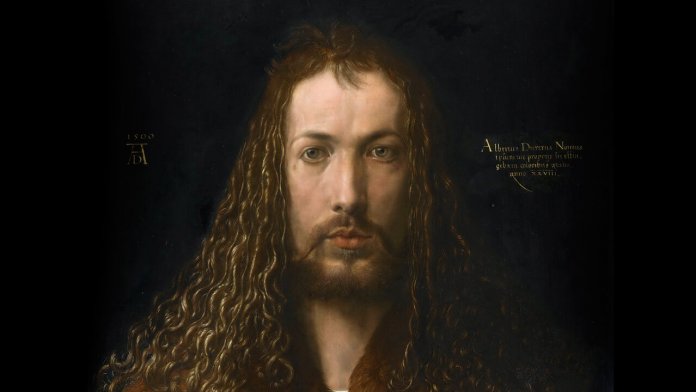Do you know who was the first in German painting who dared to draw completely naked people in full size? It was the great painter Albrecht Durer. Moreover, he drew not some dirty pictures for sexually preoccupied people, but our ancestors - Adam and Eve.
The complete list of Albrecht Dürer's works includes about 150 paintings, portraits, woodcuts and copper. And on a trip across the Alps from Venice, he painted a series of topographic watercolors that some art connoisseurs say were the first clean landscapes in art history.
Introducing the top 10 the most famous paintings by Albrecht Durer.
10. Adam and Eve
 One of the most famous works of Dürer - the diptych "Adam and Eve" - shows the perfection of the first pair of the world before the Fall. On two boards, painted in oil, the artist shows Adam and Eve in idealized, almost symmetrical poses on either side of the Tree of Knowledge.
One of the most famous works of Dürer - the diptych "Adam and Eve" - shows the perfection of the first pair of the world before the Fall. On two boards, painted in oil, the artist shows Adam and Eve in idealized, almost symmetrical poses on either side of the Tree of Knowledge.
The figure of Adam was inspired by the Hellenistic sculpture of Apollo Belvedere. The painting is characterized by unprecedented detail and subtlety of lines - including human skin and tree bark.
There was also a place in the picture for the Snake, which is holding the unfortunate apple by the stalk, which was the reason for the expulsion of the couple from the Garden of Eden.
9. Knight, death and the devil
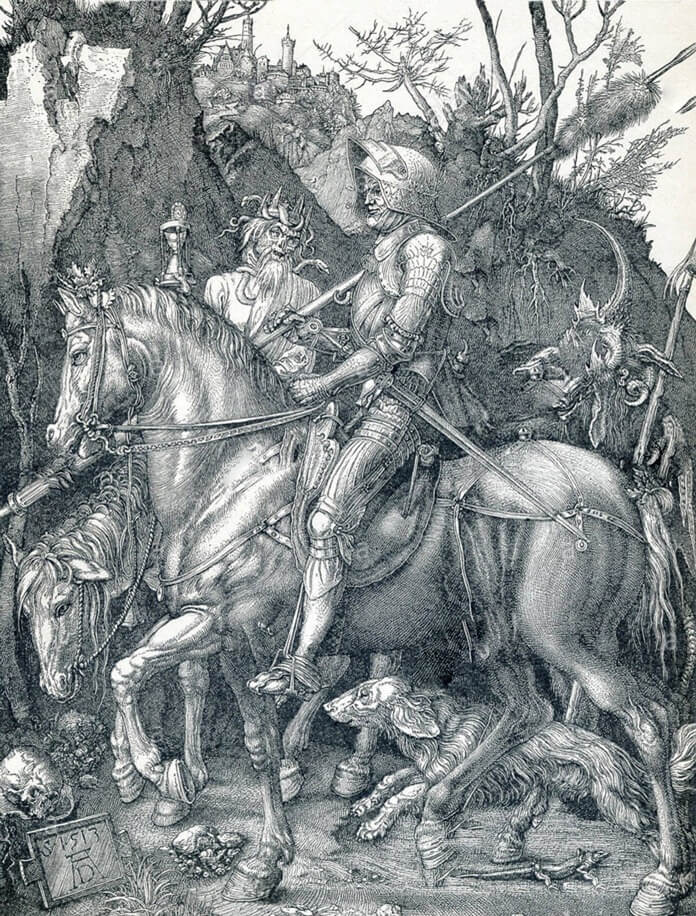 On this canvas, the viewers are presented with a nightmare gaze of Death with an hourglass in hand (a symbol of the futility of efforts and short-term life) and a pig-headed devil. But the third character in the picture - the knight - keeps calm and firmly squeezes the reins, directing the horse forward. With his armor and his faith, he is protected from danger.
On this canvas, the viewers are presented with a nightmare gaze of Death with an hourglass in hand (a symbol of the futility of efforts and short-term life) and a pig-headed devil. But the third character in the picture - the knight - keeps calm and firmly squeezes the reins, directing the horse forward. With his armor and his faith, he is protected from danger.
"Knight, Death and the Devil" was adored by Adolf Hitler on the grounds that this picture supposedly personifies a brave Teutonic hero.
The knight's horse was inspired by the project of Leonardo da Vinci - the equestrian monument of Francesco Sforza in Milan.
8. Madonna and child in front of the arch
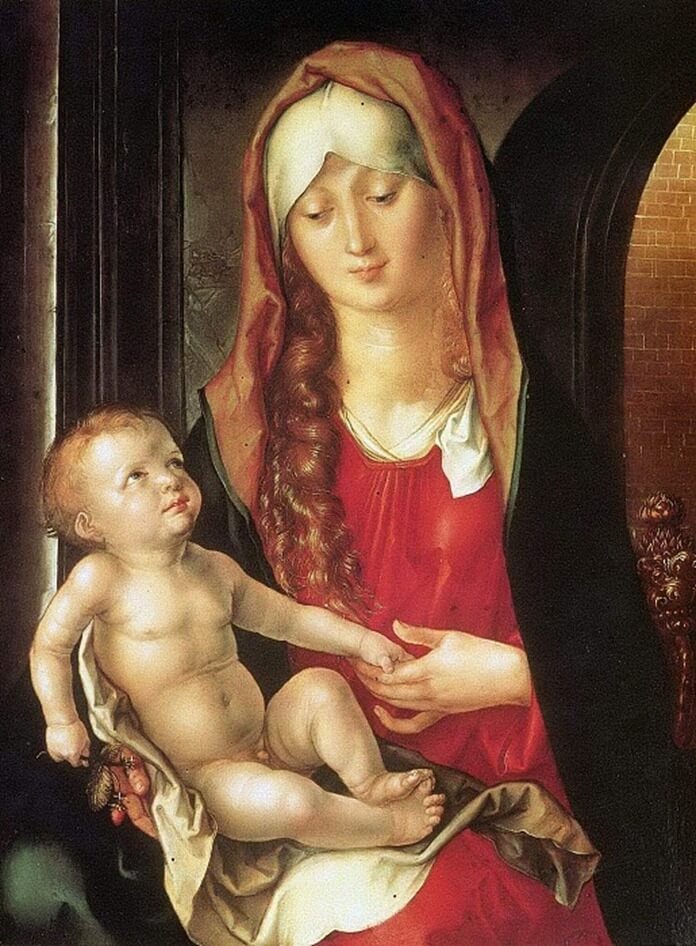 This oil painting was found after World War II in a Capuchin convent in Bagnacavallo, Italy. In 1961, the Italian art critic Roberto Longhi recognized the painting as the work of Dürer.
This oil painting was found after World War II in a Capuchin convent in Bagnacavallo, Italy. In 1961, the Italian art critic Roberto Longhi recognized the painting as the work of Dürer.
The child in the hands of the Madonna was copied from the baby Jesus from one of the paintings by the Italian artist Lorenzo di Credi (perhaps Durer met him in Venice). And the face of the Madonna resembles the features of the characters on the canvases of Giovanni Bellini, who painted several Madonnas and Babies.
The plant the child is holding has only two leaves and two strawberries. The missing leaf on the plant indicates the last member of the Holy Trinity.
7. Self-portrait of Dürer
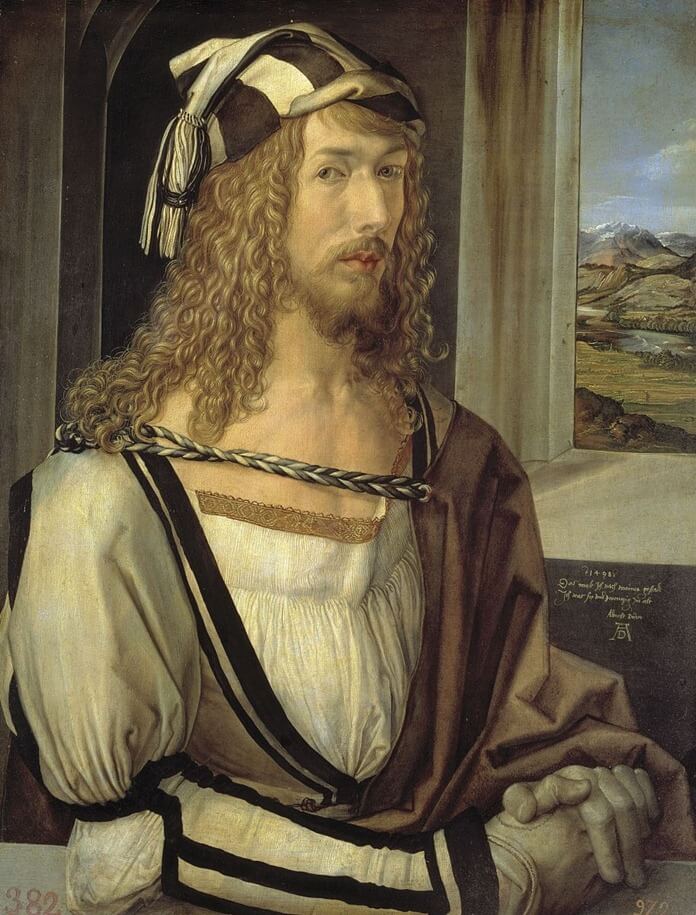
This is one of three color self-portraits of the famous painter. On it, Dürer arrogantly raised himself to a social position, which, in his opinion, corresponds to the artist of his abilities.
He wears bright, extravagant clothes that showcase the influence of Italian fashion, and expensive leather gloves.Dürer's pose is full of calmness and confidence, and he himself dominates the picturesque space of the canvas. He looks at the viewer with a cold ironic look.
It is curious that Dürer was the first Western artist to paint several self-portraits during his life. They are excellent evidence of the development of his talent. The German artist painted his first self-portrait in 1484. Then he was only 13 years old.
6. Saint Jerome in the wilderness
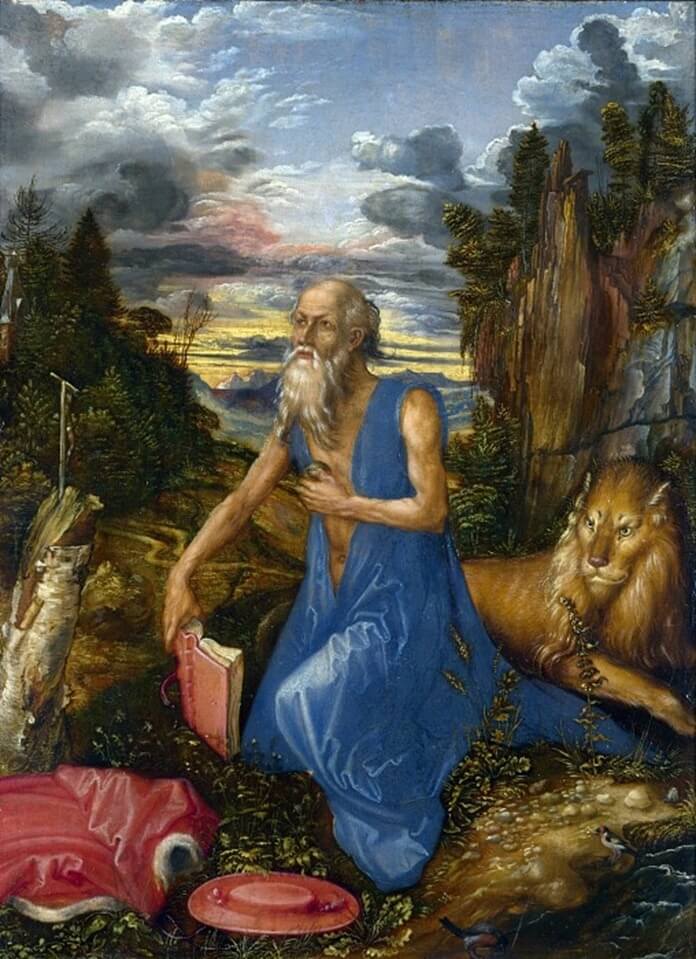 Saint Jerome of Stridon is depicted during his skete in the Chalcis desert. He is surrounded by all the symbols traditionally attributed to him: a tamed lion, a cardinal's hat and robes on the ground (a symbol of rejection of earthly honors), a book (he translated the Old and New Testaments into Latin), a stone he used to beat himself in the chest, and crucifixion.
Saint Jerome of Stridon is depicted during his skete in the Chalcis desert. He is surrounded by all the symbols traditionally attributed to him: a tamed lion, a cardinal's hat and robes on the ground (a symbol of rejection of earthly honors), a book (he translated the Old and New Testaments into Latin), a stone he used to beat himself in the chest, and crucifixion.
By the way, Jerome is considered the patron saint of translators.
There is also an image on the back of the picture - an intriguing image that resembles a meteor or a comet. Perhaps, when creating it, Dürer was inspired by the depiction of comets in the Nuremberg Chronicle of 1493.
5. Portrait of Frederick III the Wise
 The top 5 of Albrecht Dürer's most famous works opens with a painting that was one of the first orders received by Dürer from Frederick III, Elector of Saxony.
The top 5 of Albrecht Dürer's most famous works opens with a painting that was one of the first orders received by Dürer from Frederick III, Elector of Saxony.
Frederick liked the portrait so much that he became the artist's patron, regularly giving him money orders.
The importance of Frederick's personality, as well as his status, is underlined by the large beret and his determined gaze.
4. Seven sorrows of a virgin
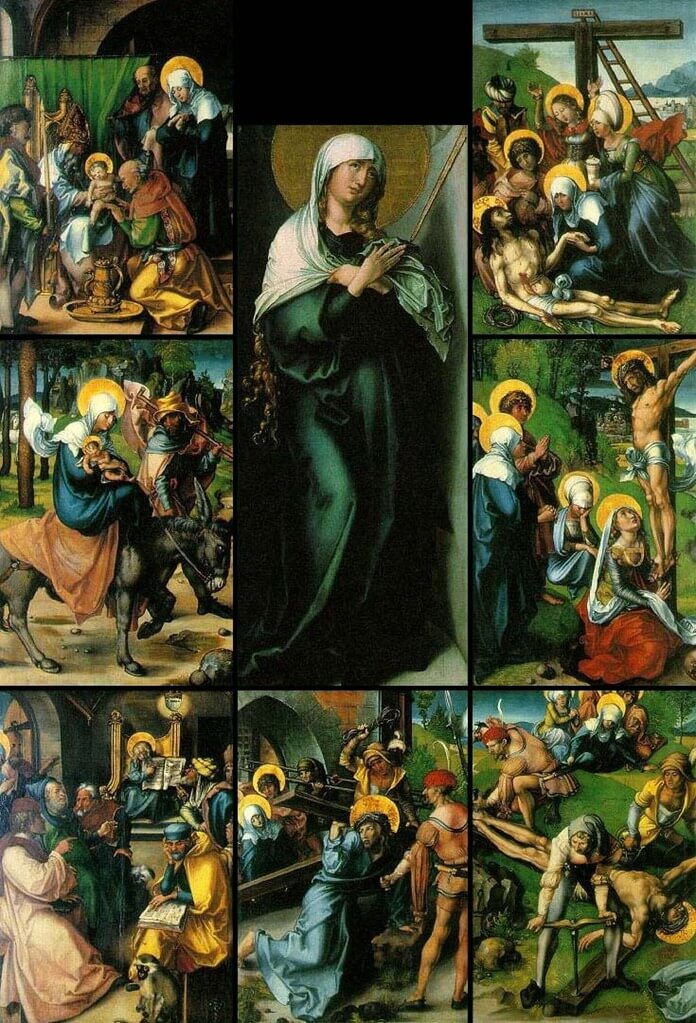 This polytych includes a central image measuring 108 x 43 cm and seven adjacent panels (approximately 60 x 46 cm). These include:
This polytych includes a central image measuring 108 x 43 cm and seven adjacent panels (approximately 60 x 46 cm). These include:
- "Circumcision of Christ".
- "Flight to Egypt".
- "Twelve Years of Christ in the Temple."
- "Carrying the Cross".
- "Nailing Christ to the Cross".
- "Christ on the Cross".
- Lamentation of Christ.
The work was commissioned by Frederick III, Elector of Saxony.
Modern scholars tend to ascribe only the central panel to Dürer; others were probably made by his students from the master's drawings. The central panel depicts the grieving Mother of God, while the rest of the polyptych depicts Jesus at different moments of his earthly life.
3. Hands of the Praying One
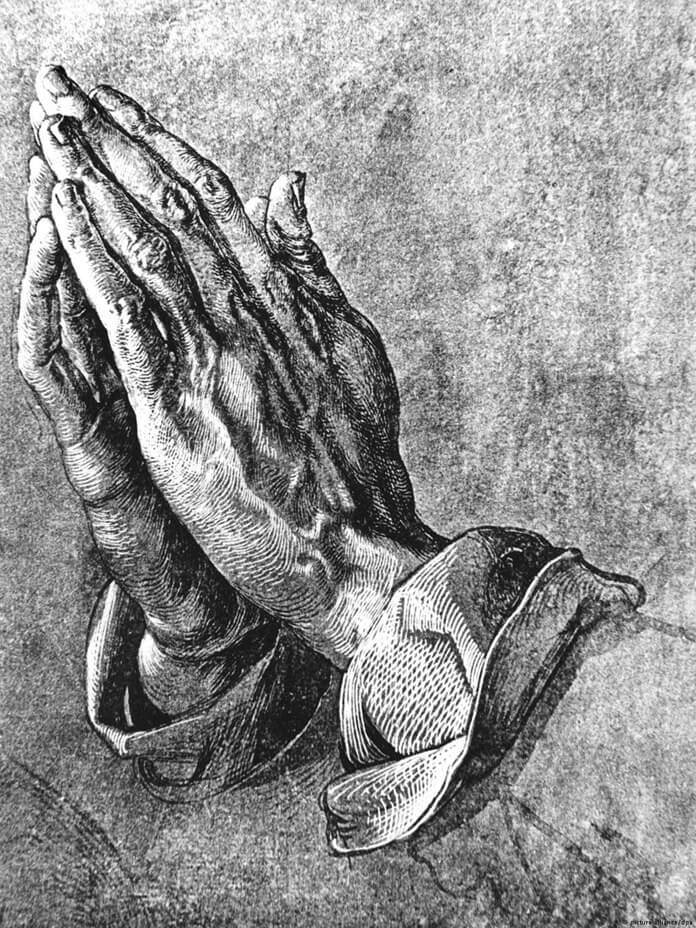 This is one of Dürer's most popular paintings. The image of praying hands can often be found on postcards expressing condolences, they were illustrated with various editions of the Bible.
This is one of Dürer's most popular paintings. The image of praying hands can often be found on postcards expressing condolences, they were illustrated with various editions of the Bible.
The Praying Hands is a sketch for the hands of the apostle, whose figure was to occupy the central panel of a triptych called Geller's Altar. But we will never see this painting, as it was destroyed by fire in 1729 in a fire in the Munich residence.
2. Adoration of the Magi
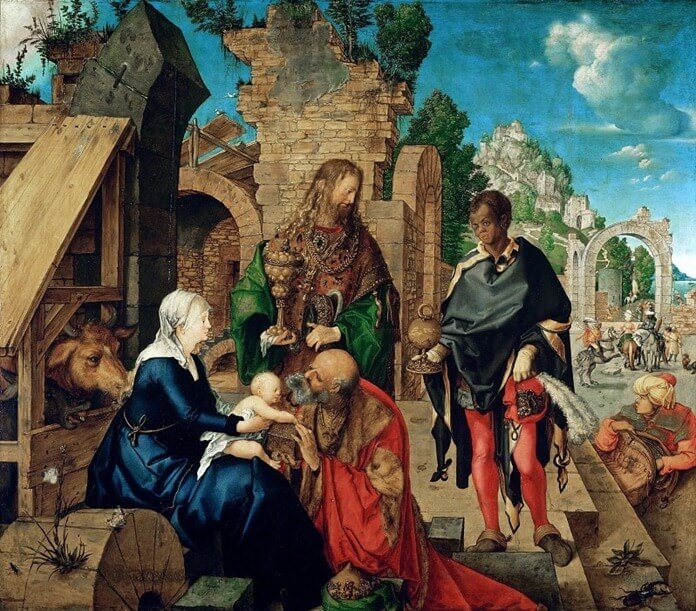 The rich colors characteristic of the Italian Renaissance, combined with German meticulousness in detail, made it possible to create one of Dürer's most outstanding and significant paintings.
The rich colors characteristic of the Italian Renaissance, combined with German meticulousness in detail, made it possible to create one of Dürer's most outstanding and significant paintings.
The artist deviated from the tradition of depicting a magnificent motorcade of the Magi. Instead of a large crowd, several horsemen are visible in the picture (in the background), and next to the Magi there is only one person from the retinue.
The painter did not forget to depict himself in the picture. If you looked closely, you probably saw him - this is the central figure of the king in green robes and long curly hair, typical of Dürer.
1. The four horsemen of the Apocalypse
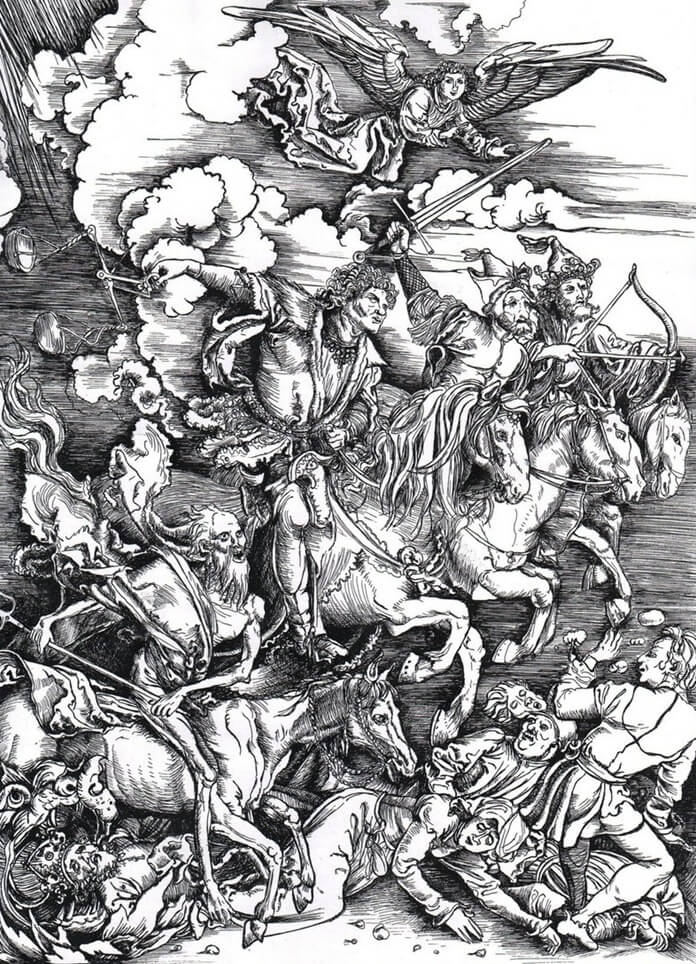 Even if you confuse "Durer" and "Fuhrer", then you may have seen "The Four Horsemen of the Apocalypse" at least once. Not literally, of course. However, this is the most famous of Dürer's engravings on the biblical Apocalypse.
Even if you confuse "Durer" and "Fuhrer", then you may have seen "The Four Horsemen of the Apocalypse" at least once. Not literally, of course. However, this is the most famous of Dürer's engravings on the biblical Apocalypse.
The Horsemen are Conquest, War, Hunger and Death. Moreover, the last horseman is depicted not in the form of a skeleton with a scythe, but in the form of a skinny bearded man with a trident. And Hell (in the form of a monster at the bottom left) followed them.
In total, Dürer in the period from 1496 to 1498 created 15 "apocalyptic" engravings, which were very popular. The fact is that people were afraid that the end of the world would come in 1500, and Durer's gloomy engravings were, as they say, in a trend.Several centuries have passed, and people are still expecting the end of the world, except that now engravings have replaced pictures on the Internet.

